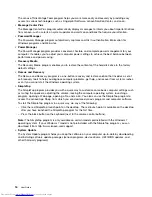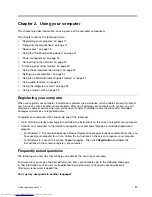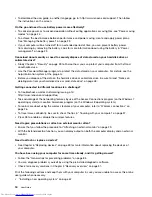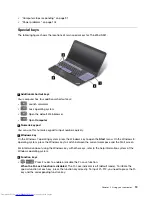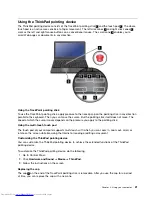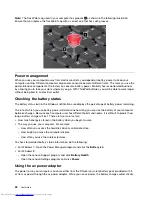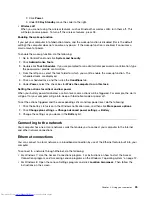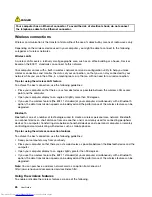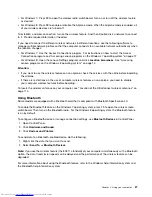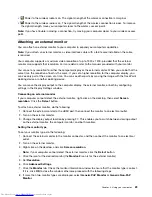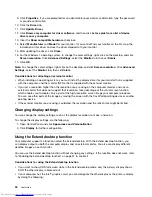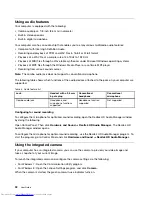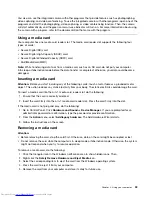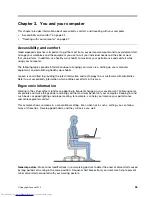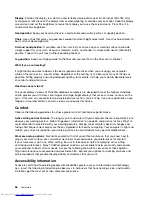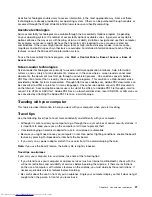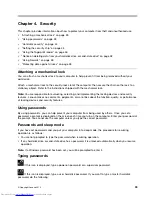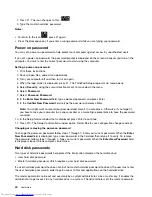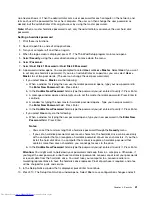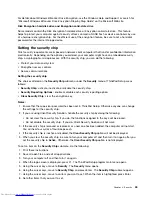
9. Click
Properties
. If you are prompted for an administrator password or confirmation, type the password
or provide confirmation.
10. Click the
Driver
tab.
11. Click
Update Driver
.
12. Click
Browse my computer for driver software
, and then click
Let me pick from a list of device
drivers on my computer
.
13. Clear the
Show compatible hardware
check box.
14. Select
Manufacturer
and
Model
for your monitor. If you cannot find your monitor on the list, stop the
installation of this driver and use the driver shipped with your monitor.
15. After updating the driver, click
Close
.
16. For the Windows 7 operating system, to change the color settings, right-click on the desktop, and click
Screen resolution
. Click
Advanced Settings
, select the
Monitor
tab, then set
Colors
.
17. Click
OK
.
Note:
To change the color settings, right-click on the desktop, and click
Screen resolution
. Click
Advanced
Settings
, select the
Monitor
tab, then set
Colors
.
Considerations for attaching an external monitor
• When installing an operating system, you must install the display driver for your monitor that is supplied
with the computer, and the monitor INF file that is supplied with the external monitor.
• If you set a resolution higher than the resolution you are using on the computer monitor, and use an
external monitor that does not support that resolution, take advantage of the virtual screen function,
which enables you to display only a part of the high-resolution screen image your computer produces.
You can see other parts of the image by moving the screen with the TrackPoint pointing device or another
pointing device.
• If the external monitor you are using is outdated, the resolution and the refresh rate might be limited.
Changing display settings
You can change the display settings, such as the display resolution, font size, and so on.
To change the display settings, do the following:
1. Open Control Panel and click
Appearance and Personalization
.
2. Click
Display
for further configuration.
Using the Extend desktop function
Your computer supports a function named the Extend desktop. With the Extend desktop function, you
can display output on both the computer display and an external monitor. You also can display different
desktop images on each monitor.
You can use the Extend desktop function without changing any settings. If the function does not work, refer
to “Enabling the Extend desktop function” on page 31 to enable it.
Considerations for using the Extend desktop function
• If you want to show DOS full-screen while in the Extend desktop mode, only the primary display shows
DOS; the other display is blacked out.
• If your computer has the Intel
®
graphics card, you can designate the other display as the primary display
by doing the following:
30
User Guide
Summary of Contents for ThinkPad S531
Page 1: ...User Guide ThinkPad S531 ...
Page 6: ...iv User Guide ...
Page 16: ...xiv User Guide ...
Page 66: ...50 User Guide ...
Page 74: ...58 User Guide ...
Page 106: ...90 User Guide ...
Page 124: ...108 User Guide ...
Page 134: ...118 User Guide ...
Page 138: ...122 User Guide ...
Page 145: ...Appendix F Eurasian compliance mark Copyright Lenovo 2013 129 ...
Page 146: ...130 User Guide ...
Page 147: ......
Page 148: ......

